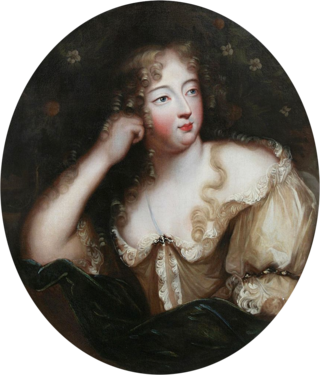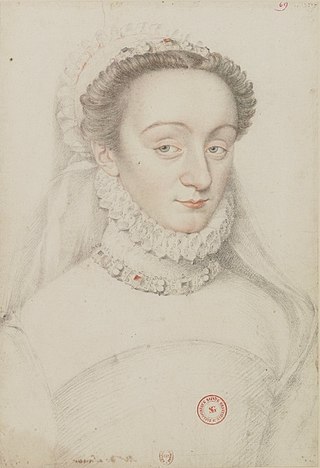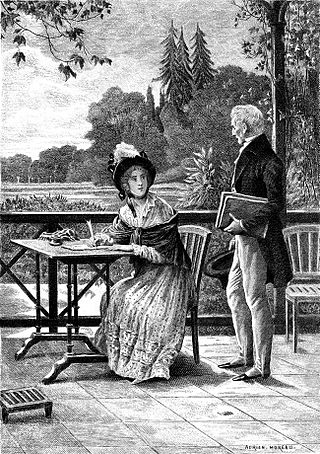
Amantine Lucile Aurore Dupin de Francueil, best known by her pen name George Sand, was a French novelist, memoirist and journalist. One of the most popular writers in Europe in her lifetime, being more renowned than either Victor Hugo or Honoré de Balzac in England in the 1830s and 1840s, Sand is recognised as one of the most notable writers of the European Romantic era. She has more than 50 volumes of various works to her credit, including tales, plays and political texts, alongside her 70 novels.

Dangerous Liaisons is a 1988 American period romantic drama film directed by Stephen Frears from a screenplay by Christopher Hampton, based on his 1985 play Les Liaisons dangereuses, itself adapted from the 1782 French novel of the same name by Pierre Choderlos de Laclos. It stars Glenn Close, John Malkovich, Michelle Pfeiffer, Uma Thurman, Swoosie Kurtz, Mildred Natwick, Peter Capaldi and Keanu Reeves.

Françoise-Athénaïs de Rochechouart de Mortemart, Marquise of Montespan, commonly known as Madame de Montespan, was a French noblewoman and the most celebrated royal mistress of King Louis XIV. During their romantic relationship, which lasted from the late 1660s to the late 1670s, she was sometimes referred to as the "true Queen of France" due to the pervasiveness of her influence at court.

Les Liaisons dangereuses is a French epistolary novel by Pierre Choderlos de Laclos, first published in four volumes by Durand Neveu from March 23, 1782.

Le Rouge et le Noir is a historical psychological novel in two volumes by Stendhal, published in 1830. It chronicles the attempts of a provincial young man to rise socially beyond his modest upbringing through a combination of talent, hard work, deception, and hypocrisy. He ultimately allows his passions to betray him.

Marie Adélaïde of Savoy was the wife of Louis, Dauphin of France, Duke of Burgundy. She was the eldest daughter of Victor Amadeus II, Duke of Savoy, and of Anne Marie d'Orléans. Her betrothal to the Duke of Burgundy in June 1696 was part of the Treaty of Turin, signed on 29 August 1696. She was the mother of the future King Louis XV of France. Styled as Duchess of Burgundy after her marriage, she became Dauphine of France upon the death of her father-in-law, Le Grand Dauphin, in 1711. She died of measles in 1712, followed by her husband a week later.

Paul et Virginie is a novel by Jacques-Henri Bernardin de Saint-Pierre, first published in 1788. The novel's title characters are friends since birth who fall in love. The story is set on the island of Mauritius under French rule, then named Île de France. Written on the eve of the French Revolution, the novel is recognized as perhaps Bernardin's finest work. It records the fate of a child of nature corrupted by the artificial sentimentality of the French upper classes in the late eighteenth century. Bernardin de Saint-Pierre lived on the island for a time and based part of the novel on a shipwreck he witnessed there.

Louis-Auguste de Bourbon, duc du Maine was an illegitimate son of Louis XIV and his official mistress, Madame de Montespan. The king's favourite son, he was the founder of the semi-royal House of Bourbon-Maine named after his title and his surname.

Marie Anne de Bourbon, Légitimée de France, born Marie Anne de La Blaume Le Blanc, by her marriage Princess of Conti then Princess Dowager of Conti, suo jureDuchess of La Vallière and of Vaujours was a French noblewoman as the eldest legitimised daughter of Louis XIV, King of France, born from his mistress Louise de La Vallière, and the king's favourite daughter. She married Louis Armand I, Prince of Conti, in 1680 and was widowed in 1685. She never married again and had no issue. Upon her mother's death, she became the suo jure Duchess of La Vallière and of Vaujours.

Louise Élisabeth de Bourbon was a daughter of Louis III de Bourbon, Prince of Condé, and his wife, Louise Françoise de Bourbon, légitimée de France, a legitimised daughter of King Louis XIV of France and his famous mistress, Madame de Montespan.

Charlotte de Beaune Semblançay, Viscountess of Tours, Baroness de Sauve, Marquise de Noirmoutier was a French noblewoman and a mistress of King Henry of Navarre, who later ruled as King Henry IV of France. She was a member of queen mother Catherine de' Medici's notorious "Flying Squadron", a group of beautiful female spies and informants recruited to seduce important men at Court, and thereby extract information to pass on to the Queen Mother.

Mémoires de deux jeunes mariées is an epistolary novel by the French writer Honoré de Balzac. It was serialized in the French newspaper La Presse in 1841 and published by Furne in 1842 as the first work in the second volume of Balzac's La Comédie humaine. It was dedicated to the French novelist George Sand. The 1902 English translation of the novel included a preface by Henry James.

Marie Anne de Bourbon, Duchess of Bourbon was a princess of the blood at the French court of Versailles. She was the first wife of Louis Henri, Duke of Bourbon. She died childless during the Regency of Philippe II, Duke of Orléans, who was her husband's uncle. Marie Anne was known as "the younger duchess" to distinguish her from her mother-in-law, Louise-Françoise de Bourbon. Despite her husband being the Prince of Condé, he continued to use the title of Duke of Bourbon, the title by which his wife was known.

Louise Anne de Bourbon, Mademoiselle de Charolais was a French princess, the daughter of Louis III de Bourbon, Prince of Condé. Her father was the grandson of le Grand Condé, while her mother, Louise Françoise de Bourbon, was the eldest surviving legitimised daughter of Louis XIV of France and his maîtresse-en-titre, Madame de Montespan.

Jeanne Baptiste d'Albert de Luynes, comtesse de Verrue was a French noblewoman and the mistress of Victor Amadeus II of Sardinia.

Élisabeth of Lorraine was a French noblewoman and the Princess of Epinoy by marriage. She is often styled as the princesse de Lillebonne. She was the mother of Louis de Melun, Duke of Joyeuse and of Anne Julie de Melun, princesse de Soubise.
Zeluco is a 1789 novel by Scottish author John Moore that centers on the vicious deeds of the eponymous anti-hero, the evil Italian nobleman Zeluco. The novel's full title is Zeluco: Various Views of Human Nature, Taken from Life and Manners, Foreign and Domestic. A combination of proto-Gothic villainy and Enlightenment rationality, Zeluco contains both main plot incidents and lengthy sections of social commentary.

Catel Muller, who publishes under the name Catel, is a French comic book artist and illustrator.
Madame Solario is a 2012 French drama film written, produced and directed by René Féret, based on the 1956 novel of the same name by Gladys Huntington. It concerns a young divorcee, of the title, and her brother, whose presence and relationship disrupts the calm of a grand lakeside hotel in the early 1900s.

Claire Bouilhac is a French bande dessinée illustrator, scriptwriter, and colorist, working in particular for Spirou and Fluide Glacial. She mainly draws the series Maude Mutante, Francis Blaireau Farceur, and Melody Bondage. She is a 2022 laureate of the Prix Schlingo.




















